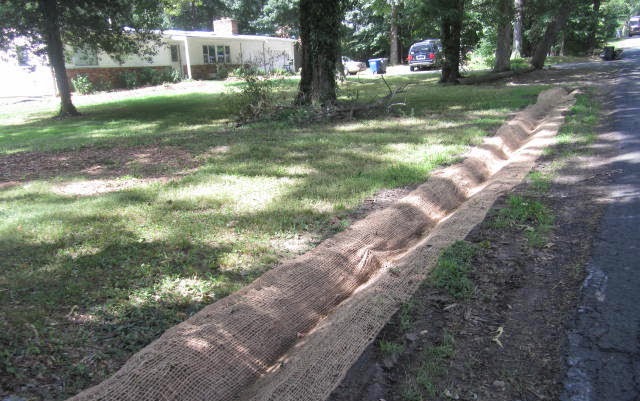VDOT outlines drainage plan for Annandale Acres
 |
| A burlap-lined ditch on Auburn Street recently put in by VDOT. |
The Virginia Department of Transportation has come up with a preliminary plan for a permanent solution to the drainage problem in Annandale Acres. The estimated cost is $5.6 million and Fairfax County’s share of the cost is expected to be an equal amount.
It’s not clear where the money will come from or how the responsibilities for implementing the plan would be divided between VDOT and the county. And at this point, it’s far from certain whether it would ever be implemented.
 |
| A ditch along Auburn Street comes to a dead end at a driveway. |
The Annandale Acres community doesn’t have storm drains, sidewalks, or curbs, and the streets and yards often flood when there is heavy rain. Many residents have had to carry out costly repairs to their homes’ foundations. Recent infill development in the area has made the problem worse.
In May, Amy Whetzel, a resident of Auburn Street, persuaded her representative in the Virginia Senate, Majority Leader Dick Saslaw, to convene a meeting in the neighborhood to discuss the need for a long-term solution to the flooding problem. Mason Supervisor Penny Gross, aides from Del. Kaye Kory’s office, and several Fairfax County and VDOT officials attended.
VDOT promised to come up with a comprehensive plan to improve drainage within a month. As an interim measure, VDOT has dug a few foot-deep ditches along Auburn Street.
Some of the ditches are lined with burlap and others are just dirt. There are no pipes underneath driveways, however, and there aren’t any pipes directing water anywhere. If there is heavy rain, the ditches will simply overflow, so “it’s not a holistic solution,” Whetzel says.
VDOT’s long-term plan, outlined in a letter to Saslaw from Lauren Mollerup, VDOT’s transportation and land use director for Arlington and Fairfax counties, calls for a system of driveway culverts about 30 feet long and 18 inches in diameter, roadway ditches about 18 inches deep on both sides of roads, and one or more water-quality swales.
The costs would cover hydraulic and hydrologic analysis, engineering, construction, stormwater management requirements, low-impact development swales, roadside ditches, utility relocation, and right-of-way estimates. Paving of the roadway would not be included in the cost estimate.
All Annandale Acres residents would have to be on board if the project is to proceed. And that means people are going to have to give up some right-of-way on their property, as VDOT isn’t expected to pay condemnation costs. It would only take one person who opposes it for the whole project to be killed.


As you rightly point out, "Recent infill development in the area has made the problem worse." Heavy development, impermeable surfaces, the roofs, roads, and driveways – not only in Annandale Acres, but throughout the watershed, mean rain no longer sinks into soil, slowing and cleaning as it goes. If every house caught even some of the rain from its roof in rain barrels and cisterns and rain gardens, used gravel instead of asphalt, we'd mitigate not only flooding, but we'd capture water – an increasingly scarce resource – that is just rushing down the drain.
Thank you for that. One of the problems with storm water management in Mason District is a lack of will on the part of the supervisor and the department of planning and zoning. A few years ago I had asked for a simple modification to the storm water plan of a recent development, DeGroff Court, which is up stream of Annandale Acres. This modification would take advantage of underutilized capacity of the new development’s retaining pond by passing direct run off from an older neighborhood through the new pond. This additional run off would then be retained if unused capacity was available or automatically passed through if not. The developer thought it no problem but the Supervisor and Planning and Zoning would not support it basically because it was outside-of-the-box thinking. A simple technique that would have retained a lot of water and mitigated a 40 year unsolved flooding problem, but it wasn’t specifically in the Public Facilities Manual so it didn’t happen. That water will no doubt continue to run direct to the Chesapeake Bay and contribute to downstream flooding problems for decades to come.